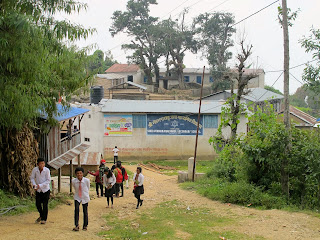 Deeply affected by the earthquake and seeing first-hand its
devastating impact, Binod committed to supporting the rebuilding of 10,000
homes and 100 schools across the country. Through his Foundation, $2.5 million was
pledged to restore schools and homes destroyed or damaged by the quake. Since
that day, through its global network of businesses, the Chaudhary family have worked
tirelessly to make the Foundation a hub for private-sector donations, achieving
traction and results where the government, IGOs and NGOs have struggled or failed.
The Foundation has already been successful in building an initial 1,000
transitional bamboo-and-plaster homes and has committed to working with partners
and donors globally to construct another 9,000.
Deeply affected by the earthquake and seeing first-hand its
devastating impact, Binod committed to supporting the rebuilding of 10,000
homes and 100 schools across the country. Through his Foundation, $2.5 million was
pledged to restore schools and homes destroyed or damaged by the quake. Since
that day, through its global network of businesses, the Chaudhary family have worked
tirelessly to make the Foundation a hub for private-sector donations, achieving
traction and results where the government, IGOs and NGOs have struggled or failed.
The Foundation has already been successful in building an initial 1,000
transitional bamboo-and-plaster homes and has committed to working with partners
and donors globally to construct another 9,000. “Our hope is that very quickly we’ll be able to find the right partners who will support us in doing jointly the 10,000-home target that we’ve set for ourselves, and hopefully much more than 100 schools that we’re planning to restore.”
 Following a tour of his modest home, one of the residents of
a ‘transitional shelter’ village just outside of Bhaktapur, proudly told me
that his structure will last at least five years, giving him and his family
time to make arrangements for more permanent residences without having to take
loans or cut back on food. Holding his baby daughter in his arms he beamed, “I
am so proud and happy with my new home.” His was one of the biggest smiles that
saw during my visit to the country and one that I’ll not soon forget.
Following a tour of his modest home, one of the residents of
a ‘transitional shelter’ village just outside of Bhaktapur, proudly told me
that his structure will last at least five years, giving him and his family
time to make arrangements for more permanent residences without having to take
loans or cut back on food. Holding his baby daughter in his arms he beamed, “I
am so proud and happy with my new home.” His was one of the biggest smiles that
saw during my visit to the country and one that I’ll not soon forget.No country, community, government or company can ‘go it alone.’ What becomes clear from conversations with organisations working to deliver change in Nepal is that in today’s complex, hyper-linked environments and communities, no single entity – government, public or private – possesses all of the necessary powers, resources, or expertise to assure resilience against natural disasters and catastrophic events – be it earthquakes, floods, tornados or tsunamis. Key ingredients to effective solutions include collaborative and organised approaches, leveraging the capabilities and capacity of stakeholders from government, the private sector, local communities and society as a whole. As highlighted by The Chaudhary Foundation’s efforts in Nepal, both short term and long term, as a global community, we’re all going to have to work together with everyone’s best interest in mind to respond quickly and efficiently to current challenges and to prevent such disasters from happening again in the future.





































































